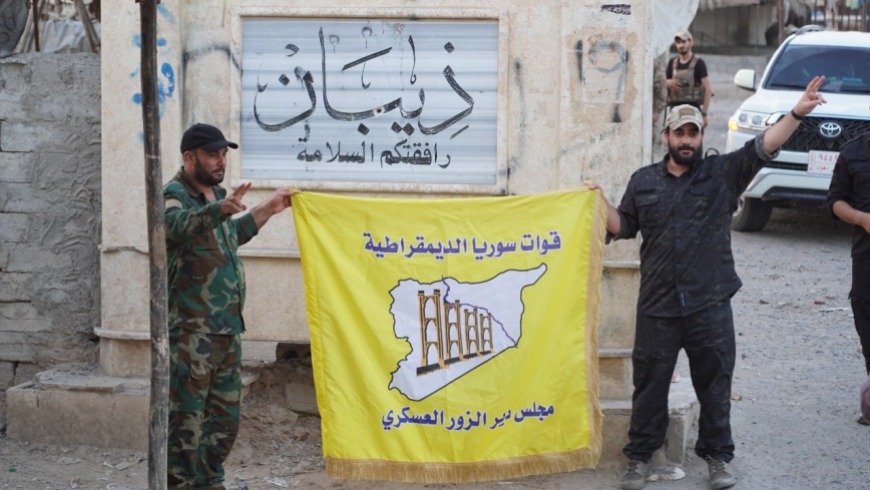More than a week has passed since the outbreak of tribal clashes with the Syrian Democratic Forces (SDF) in the rural areas of Deir ez-Zor. As a consequence, many villages and towns in the eastern and northern countryside of the governorate have fallen under clan control. Despite three failed attempts by the SDF to storm the town of Dhiban, a recent announcement claiming their control over it has given rise to numerous questions and speculations.
A few hours after news of renewed clashes surfaced on the outskirts of Dhiban, in the early hours of Wednesday, the SDF declared its dominion over the town. Dhiban, which serves as the stronghold of Sheikh Ibrahim al-Hafel of the al-Akidat tribe, is located in the eastern countryside of Deir ez-Zor. The SDF wasted no time in disseminating what it termed “live and direct scenes from inside Dhiban,” emphasizing its significance as the last bastion of tribal groups and the center of Sheikh Hafel’s authority, across various social media platforms.
The SDF asserted that its entry into the town and the subsequent consolidation of control were the results of “mediation by several tribes with tribal forces.” These tribal groups played a pivotal role in facilitating the SDF’s peaceful entrance into Dhiban, sparing any further bloodshed. However, the specific names of these tribes have not been disclosed.
Full control of Dhiban
Following the announcement of its firm control over Dhiban, the SDF emphasized that the “bloody clashes with tribal factions in Deir ez-Zor have ceased, resulting in the loss of 90 lives.”
In addition, a confidential source confirmed to the Syria TV website that the SDF has achieved “complete control over Dhiban.” The source further revealed that the SDF had established a presence in the heart of the town, specifically in the Latwa neighborhood.
Furthermore, the source disclosed that the SDF had conducted thorough searches of several houses within the town, utilized schools as strategic points for its forces, and set up multiple checkpoints throughout the area.
The fate of Sheikh Hafel
The confidential source also revealed that as of Thursday afternoon, the town of al-Tayana, situated near Dhiban, remains beyond the control of the SDF. It is likely that Sheikh Hafel has fortified himself within al-Tayana alongside tribal forces.
This situation has arisen amidst uncertainty regarding the whereabouts of Sheikh Hafel, the leader of the tribal movement. Some news groups and pages with close ties to the SDF have claimed that Hafel “sought refuge in areas controlled by the Syrian regime” in Deir ez-Zor after Dhiban was captured.
According to the source, the SDF’s strategy, beginning with the siege of Dhiban, was aimed at “pressuring Sheikh Hafel and tribal fighters and their families to flee to regime-held areas.” This tactic was employed to substantiate the SDF’s assertions of a connection between the tribal movement and the Syrian regime.
Subsequently, activists in the Deir ez-Zor countryside circulated a recorded speech by Sheikh Hafel, urging tribal fighters to continue resisting the SDF militias in the governorate’s rural areas. Two days prior to the siege and capture of Dhiban, the SDF had managed to gain control of the al-Busaira region and later the town of al-Shuhail following the withdrawal of tribal fighters to Hawaij and Dhiban.
The SDF conducted house-to-house searches in al-Shuhail, initiated arrest operations affecting several residents, and concurrently carried out raids and arrests in the towns and villages of al-Sour, northeast of Deir ez-Zor. Sniper teams and checkpoints were deployed on the outskirts.z
The SDF’s capture of these areas and its pursuit of tribal fighters in them weakened Dhiban’s defenses, with the town’s defense largely left to local fighters from Dhiban itself and a few fighters from areas recently taken over by the SDF. This made it easier for the SDF to enter the town and solidify its control.
Regarding the role of the United States in the SDF’s advances, it is important to note that the ambiguity surrounding the US position on the conflict between the SDF and tribal factions may have played a significant role in the SDF’s gains. Despite the close alliance between the SDF and the United States, the US has been cautious about diminishing Arab influence in Deir ez-Zor governorate, with a focus on not upsetting the regional balance “under the influence of Iranian militias.”
Nevertheless, sources close to the international coalition forces disclosed that US forces in northeastern Syria have reservations about Sheikh Hafel. American diplomats reportedly communicated with Sheikh Musab al-Hafel, brother of Sheikh Ibrahim, who resides in Doha, Qatar, on September 2nd. During these communications, Washington clarified that it is not a party to the conflict and will not target the Arab component.
These sources explained that the American side sought to encourage Musab to expand the role of his uncle, Sheikh Hafel al-Jadaan, in leading the al-Akidat tribe. The American side appears to have more trust in Hafel, who resides in the United States, and has doubts about Ibrahim’s positions and his potential decisions concerning dealings with the international coalition forces.
This article was translated and edited by The Syrian Observer. The Syrian Observer has not verified the content of this story. Responsibility for the information and views set out in this article lies entirely with the author.


